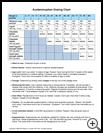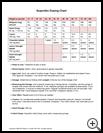
Bone, Muscle, or Joint Injury
What are the types of injuries?
The most common leg and arm injuries are fractures, sprains, strains, and bruises. Some injuries can be treated at home, while others need to be treated or checked by your healthcare provider. Read the injury descriptions below and follow the instructions for care.
Fractures
A fracture is a break or crack in the bone and needs to be treated by a doctor. If you think your child has a broken bone, follow the first aid instructions below.
First Aid
- Shoulder or arm: Use a sling made of a triangular piece of cloth. A cold pack may help. Drive your child to the doctor.
- Leg: Use padded boards, pillows, or newspapers to splint the fracture. At a minimum, carry your child and don't permit your child to put any weight on the leg. A cold pack may help. Drive your child to the doctor.
- Neck: Protect the neck from any turning or bending. Do not move your child until a neck brace or spine board has been applied. Call a rescue squad (911) for help.
Sprains
Sprains are stretches or tears of ligaments (bands of tissue that connect one bone to another). They are caused by sudden twisting injuries and require medical attention (unless they are very mild). Knees and ankles are often sprained.
First Aid
- Immediately wrap the injured area with an elastic bandage and put ice on the injury to reduce bleeding, swelling, and pain. The more the bleeding and swelling, the longer the recovery.
- While some mild sprains can be cared for at home, most injuries to ligaments need to be checked by your healthcare provider. You can drive your child to the doctor.
Home Care
Treat most sports injuries with R.I.C.E. (rest, ice, compression, and elevation) for the first 24 to 48 hours.
- Apply compression with a snug, elastic bandage for 48 hours. Numbness, tingling, or increased pain means the bandage is too tight.
- Apply a cold pack or crushed ice in a plastic bag for 20 minutes. Avoid frostbite. Repeat every hour for 4 hours.
- Give acetaminophen or ibuprofen as needed for pain relief. Continue for at least 48 hours.
- Keep injured ankle or knee elevated and at rest for 24 hours. After 24 hours, allow any activity that doesn't cause pain.
- After 48 hours, you can use a heating pad for 10 minutes a few times per day to help absorb the blood.
Strains
Strains are stretches, pulls, or tears of muscles. They are usually caused by overexertion (for example, when several muscles hurt after a strenuous practice, athletic game, or long hike). Most muscle injuries can be cared for safely at home.
Home Care
- Put an ice bag or cold pack on the area for 20 minutes. Repeat this 3 to 4 times the first day.
- Give your child acetaminophen or ibuprofen for at least 48 hours.
- If stiffness continues after 48 hours, have your child soak in a hot bath. If the pain is in one particular area, use a heating pad or hot compresses. Apply heat for 10 minutes 3 times a day until it improves.
Your child should learn about stretching exercises and return to exercise gradually. Next time, your child should be in better condition before going full throttle. Getting back in condition takes at least 7 days.
Bruises
Bruises of muscles are the most common injury in contact sports and can also be treated at home. Bone bruises usually follow direct blows to the bone in exposed areas (for example, the elbow, hip, or knee) and are usually minor injuries.
Home Care
- Put an ice bag or cold pack on the area for 20 minutes. Repeat this 3 to 4 times the first day. After 48 hours apply heat with a heating pad or hot compresses for 10 minutes 3 times a day.
- Give your child acetaminophen or ibuprofen for severe pain.
- Rest the injured part as much as possible. The pain usually starts to ease after 48 hours, but there may be some discomfort for 2 weeks.
When should I call my child's healthcare provider?
Call IMMEDIATELY if:
- The bone is deformed or crooked.
- Your child won't use an arm normally (especially if the injury occurred after someone pulled on the arm). Young children who won't straighten the elbow or turn the palm up usually have a partial dislocation of the elbow.
- Your child won't stand on the injured leg.
- The pain is severe.
- Your child can't walk without pain and a limp.
Call during office hours if:
- The pain is not improving by 3 days.
- The pain is not gone by 2 weeks.
- You have other concerns or questions.
Last modified: 2017-06-05
Last reviewed: 2017-06-05


